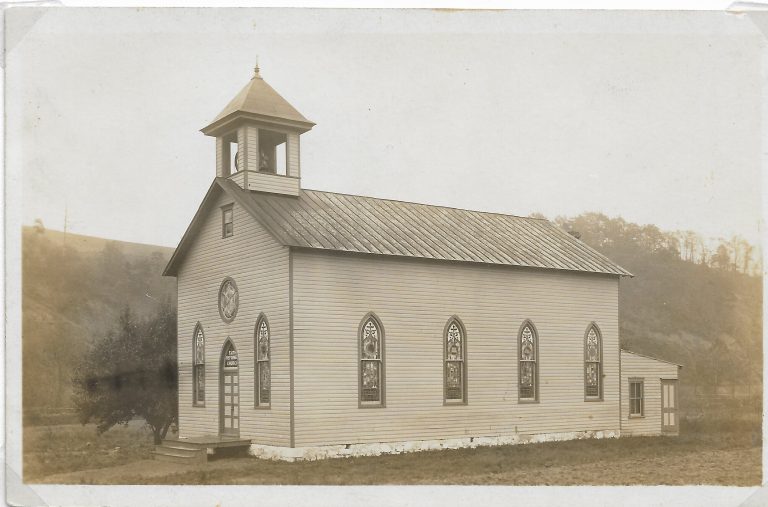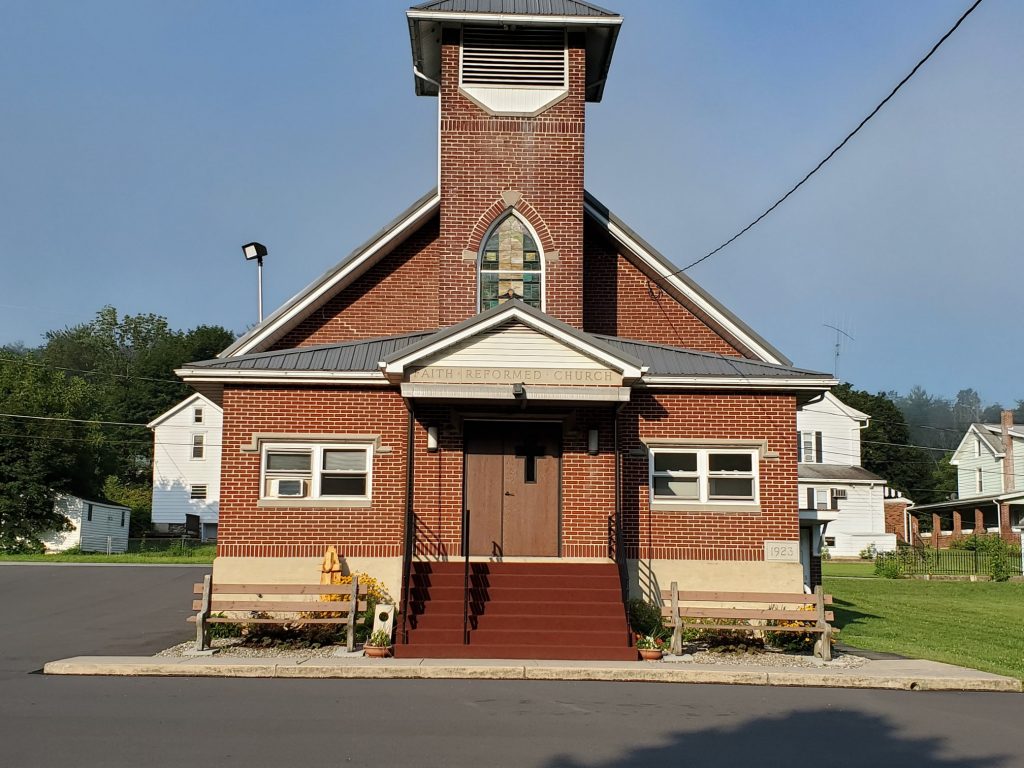
Church Building 1902-1923
A Brief History
It was natural that German immigrants to this country would seek each other out for support and fellowship in their new land. This trend, along with facing common challenges and dangers, issued forth a new venture in churches, the Union Church. German Lutherans, Reformed and Evangelical people often combined their resources and talents to build one church to serve two or more groups, either as one congregation or as two congregations using the same facilities. Faith Church, as well as St. John in Auburn, Zion Red Church, and St. Paul’s in Summer Hill were all union churches in their beginnings.
St. Paul’s became two congregations and Faith Reformed Congregation became independent. Red Church (Zion’s), and St. John are atill joint ministries of two groups.
On January 17, 1902, at the call of Mr. F. A. Heim, representing the Reformed and Lutheran people of Adamsdale and Landingville, Thirty-two men met with Pastor W.D. Stoyer of the Bethany Charge of the Reformed Church, and Pastor H. A. Weller of the Orwigsburg Lutheran Charge. They held a devotional service and decided to organize a Sunday School together.
Pastor Stoyer organized the Sunday School on January 19, preaching the sermon on that occasion. This began the church which was to be Faith Reformed Church of Landingville. Services were held in the Patriotic Order Sons of America Hall as part of this joint venture. Beginning in late August of 1902, services for each denominational group were held independently. A joint committee was organized to manage matters the congregations had in common, but friction in the committee developed by 1904 and the Reformed congregation withdrew from the union organization.
The Reformed congregation purchased the William Drumheller Knitting Mill property and refitted it for church purposes.
On September 17, 1902, the Reformed congregation had petitioned the Schuylkill Classis of the Reformed Church (group of churches and ministers) for the privilege of organizing “The Reformed Church of Adamsdale and Landingville.” A proposed constitution was also submitted with that request.
In May of 1903, the Classis approved this request. Later that month a congregational meeting was called by Rev. Stoyer and the constitution was approved. The first Confirmation Class of six members was received on November 7, 1903.
Improvements to the congregation’s property, both items and labor, were largely donated by the congregation’s artisans and by local interested parties. Everything from altar rails to roof paint were included in these gifts.
On February 12, 1906, the Rev. J. Authur Sheaffer, a student of Franklin and Marshal College, was unanimously voted in as pastor of the young church by all thirteen persons voting.
In September 19-6, a committee of representatives of Faith Reformed Church, Zion Reformed Church, St. John Reformed Church of Auburn and St. John Reformed Church of Port Clinton was formed to purchase a parsonage on Market Street in Auburn. This was the first major business transaction of what came to be a four point charge for those churches.
In January, 1922, a piano was purchased. Full payment for the piano was finally made one week before the whole church building burned to the ground on December 22, 1922. Nothing was salvaged.
On April 11, 1923, ground was broken for a new brick church building on ground purchased from Mr. Y Mrs. Samuel Deibert of Orwigsburg. The cornerstone for this building was laid on July 22, 1923, at 3:00 p.m. The Reverend E. S. Noll preached the sermon on that occasion, and prayer was offered by Harry A. Reber.
Services of dedication for the new building were held all during the week of July 1 through 8, 1924. Numerous ministers from Landingville, Auburn, Adamsdale, Orwigsburg, New York State, Philadelphia, Tamaqua, and Schuylkill Haven took part in the various services.
The mortgage on the new church was paid in full and burned on October 25, 1925. The total cost of the building was $15,000.00
The Reformed Church of the United States and the Evangelical Synod of North America merged in 1934. In 1942, Faith Reformed Church of Landgville had its name changed to Evangelical and Faith Reformed Church.
Church Building 1952-2018

Some Interesting Notes
- May 3, 1953, thanks was given to Fred Sterner for putting up signes fo Faith Reformed Church
- July 30, 1957, Rev. Zeigler suggested starting a joint youth fellowship for the Port Clinton, Auburn and Landingville churches.
- January 28, 1958: It was decided to enclose the bell tower.
- May 26, 1958: Permission was given to Ralph Fetherolf to plant two trees on church property.
- January 14, 1961: The congregation decided to begin taking Holy Communion in the pews.
In 1957, the Evangelical and Reformed Church merged with the Congregational Christian Churches of the United States to form the United Church of Christ. On June 17, 1961, the new name was adopted for the church: “Faith United Church of Christ, Landingville.” The name used by the church in recent years is “Faith Reformed United Church of Christ.”
Floods have been part of Faith Church’s life for some time. A note indicates that on June 25, 1972, the piano in the basement had to be replaced becuase it was damaged by flood waters.
The consistory was expanded to ten members at its meeting on January 15, 1974.
Concisotry approved the starting of a “Youth Movement” by Becky Schaeffer and her husbnad, Donny.
In 1982, an electronic carillon was purchased by a number of memorial and other contributions.
In September 1989, the present Allen Organ was purchased by the church
The Weil-McLain Furnace was dedicated on May 28, 1995. In June of that year the Helen Sterner Memorial Pavilion was constructed.
on September 9, 1995, the parking lot was sealed by Wayne Bertram, Ken Gerber, Kerry Gerber, Dan Strausser, Glenn Konsavage and Paul Schaeffer.
The framed needlework wall hanging of the “Last Supper” was donated to the church by Edna (Reber) Zeigler, on December 14, 1995, and hung in place by Kerry Gerber, Glenn Konsavage, and Joe Linkchorst.
Since 1995, church life has proceeded with many events which in themselves would not make histooy, but together speak volumes for the care and concern of the people of Faith Church for each oter, for the property of the church, and for the mission of the church as a group of people called to serve Jesus Christ.
